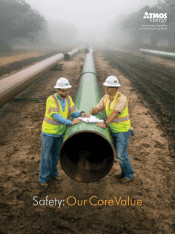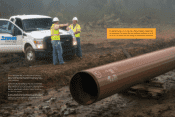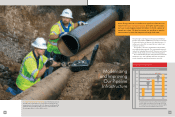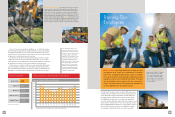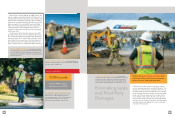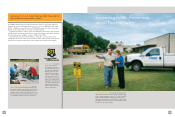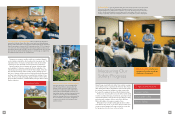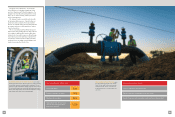Atmos Energy 2015 Annual Report Download - page 8
Download and view the complete annual report
Please find page 8 of the 2015 Atmos Energy annual report below. You can navigate through the pages in the report by either clicking on the pages listed below, or by using the keyword search tool below to find specific information within the annual report.
12 13
Our damage prevention efforts have yielded a steady
decline in damages to our pipeline systems. Since 2010, we
have reduced damages per 1,000 line locates by 11 percent.
That improvement is all the more impressive in light of the
economic development activities in our service areas that
have caused annual requests for facility-locates to rise by 24
percent since 2010 to more than 1.9 million annual requests.
Eliminating third-party damages requires vigilance and
diligence by our damage prevention specialists, who contact
repeat offenders to seek their cooperation to observe the
law and to protect their workers and the public.
An especially important part of our damage prevention
program is sponsoring training and meetings by our state
One-Call organizations to reach professional excavators.
We are a Gold Sponsor of the national Common Ground
Alliance and we are a strong ally with our states’ damage
prevention councils to promote safety.
Along with fewer damages, the number of active leaks on
our system has declined by 31 percent since 2010.
We continue to seek better leak detection technologies
as part of our comprehensive safety strategy. Innovative
gas-analysis instruments, involving mass spectroscopy, are
approximately 1,000 times more sensitive than traditional
leak detection equipment and are capable of sensing gas
leaks down to one part per billion in ambient air while
reducing false positives from naturally occurring methane.
We are conducting tests with this equipment mounted in
a vehicle to determine whether the technology can measure
and monitor methane levels from gas pipeline leaks, as
compared to methane emissions from countless other
sources, such as farm animals, vehicles and pollution.
In the center of downtown Dallas, Atmos Energy
is testing an advanced leak detection technology that is much more
sensitive for identifying methane releases than conventional methods.
The instrumentation is installed in a standard SUV, making it highly
mobile and allowing sampling to occur at driving speeds. The tech-
nician driving the vehicle also is informed in real time of potential
leaks that can be investigated promptly. Right: Brandon Nelson,
a compliance specialist in the Mid-Tex Division, and Tamera Hewitt,
a geographic information system specialist in the division, evaluate
maps from a survey to help identify areas needing closer attention
for potential leaks.
An existing natural gas pipeline (below) is located by
Jeff Knight, a crew leader in the Louisiana Division, in preparation
to install a new main to serve additional customers in Covington. Line
locators use colored flags and temporary spray paint to mark the routes
of all underground utility facilities, so that excavators know to dig only
by hand within tolerance zones around the buried lines. Line-locating
of utility lines is provided to the public free of charge.
Targeted Infrastructure Replacement
Replacing aging pipeline infrastructure and service lines helps reduce
potential leaks on our system. Since fiscal 2010, we have replaced nearly
1,000 miles of pipelines. We plan to double our replacements by fiscal 2020.
8,000
6,000
4,000
2,000
0
Miles
Bare Steel, Cast Iron and Early Generation Plastic
2010 2015 2020
975
1,950

